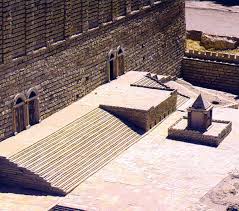 How was it possible for the disciples to suddenly have the willpower needed to change the world. We can find the answer at Pentecost, on the southern stairway at the temple mount.
How was it possible for the disciples to suddenly have the willpower needed to change the world. We can find the answer at Pentecost, on the southern stairway at the temple mount.
The southern stairs are inside the City of David, the most ancient part of the city. This was the main entrance for pilgrims coming to worship, coming by the hundreds of thousands.
The stairs have irregular widths, to force visitors to approach the temple slowly.
The staircase was also known as the rabbi-teaching staircase, as rabbis often taught at place. Some think that Jesus’ final discourse, from Matt 25, was delivered there.
At Pentecost, Jesus had already ascended, leaving the disciples without their leader — or so they would have thought. The disciples stayed continually in the temple worshiping. Where else?
When Pentecost came, 10 days after the ascension, they were likely in the temple courts, as that is where they spent time.
A violent wind came a filled the “whole house” where they were. The Jews often referred to the temple as the “house.” And where else would there be a crowd from many nations as was there?
Peter said they were speaking at 9 in the morning, which was the time of morning prayers in the temple. This where the disciples and pilgrims would have been.
The temple had several mikvehs just for the purpose of cleansing pilgrims, which would have made 3,000 baptisms possible.
Pentecost celebrated both the harvest and the giving of the Ten Commandments, believed to have occurred on Pentecost.
When Moses came down from Sinai, he had the Jews worshiping the idol killed. About 3,000 were killed. This is no coincidence.
Paul says, “The law kills and the Spirit gives life.” God called 3,000 converts to show the transition from the old house to the new house, from the temple in Jerusalem to the temple in our hearts by the Spirit. (Acts 2:38).
God said in the Law not to cut the corners of the field, to allow gleanings. True gratitude for the harvest was not just Pentecost but honoring the commands to care for the poor out of the harvest.
(Acts 2:42-47) They devoted themselves to the apostles’ teaching and to the fellowship, to the breaking of bread and to prayer. 43 Everyone was filled with awe, and many wonders and miraculous signs were done by the apostles. 44 All the believers were together and had everything in common. 45 Selling their possessions and goods, they gave to anyone as he had need. 46 Every day they continued to meet together in the temple courts. They broke bread in their homes and ate together with glad and sincere hearts, 47 praising God and enjoying the favor of all the people. And the Lord added to their number daily those who were being saved.
The believers had everything in common — caring for those in need and eating together.
The mark of the fulfillment of the true Pentecost was care for those in need. To a First Century Jew, the true sign of the coming of the Spirit and the fulfillment of Pentecost would have been concern for those in need by feeding them. This is much of what the harvest was about.





I've recently done a survey of the passages that tell us that Jesus was moved by compassion. It's a striking study. If we feed the homeless because it does something good for us, we are not being like Jesus. He helped the needy because it did something for them. Everything he did for people was motivated by compassion. Our motives tend to be much more selfish.